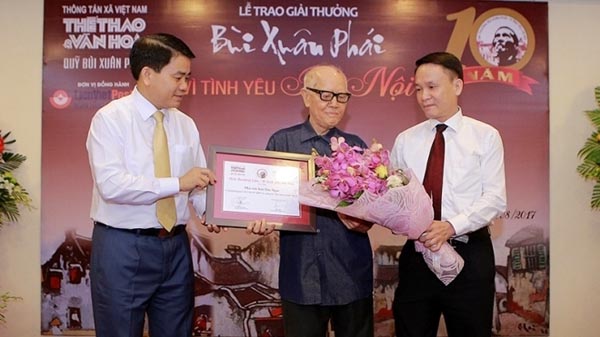


|
Veteran culturist Huu Ngoc (middle) receives the Grand Prize at the ceremony held in Hanoi on August 17, 2017 (Photo: baotintuc.vn) Cultural
researcher Huu Ngoc was born into a family in Hanoi with a rich tradition of
Confucianism. However, when he grew up he was significantly affected by
Western culture and is fluent in many foreign languages. Working in a number
of jobs relevant to culture, Ngoc contends that cultural exchange in today’s
life is a multi-dimensional interaction among countries which has posed
certain challenges in preserving a traditional and authentic cultural
essence.
On the
other hand, he recognises that cultural exchange also provides a good
opportunity for promoting the country’s cultural charm. Therefore, he has
tried to take advantage of every opportunity to advertise Vietnam’s cultural
beauty through his talks, books and articles.
In 1997,
he released a book entitled ‘A Sketch of Vietnamese Culture’ in French and in
English. The book provides readers with a full coverage of the capital Hanoi
through introductions of its streets, cuisine and customs. ‘A Sketch of
Vietnamese Culture’ was given by the Vietnamese Government as a special
present to the heads of state at the 7th Francophone Meeting in Hanoi in
1997.
Another
of Ngoc’s books which is considered as a hand-book on Hanoi is ‘Hanoi, Who
are you?’ Each volume of the book introduces readers to a different aspect of
Hanoi, such as history, Hanoi’s Old Quarter, cuisines, the name of Hanoi’s
streets, culture and arts, and education. The book has met the need of
foreign visitors to Hanoi. Released in English, the book is highly valued by
readers for its elegant language and flowing expressions.
Ngoc has
also authored a number of books on popularising Hanoi’s culture among world
readers, such as ‘Portrait of Hanoi, the 1000-year-old Dragon City’, and "My
Hanoi.’ Now when he is about to turn 100 years old, Ngoc has drafted a new
book collecting his articles which had been published in German magazines.
For his
whole-hearted contributions to the capital, Ngoc was honoured the 2017 ‘Bui
Xuan Phai – For the Love of Hanoi’ awards, following researcher Vu Tuan San,
Professor Phan Huy Len, Hanoiologist Nguyen Vinh Phuc, and photographer Le
Vuong, who were previous winners of the prestigious prize.
Through
its ten editions, the ‘Bui Xuan Phai – For the Love of Hanoi’ awards have
recognised the dedication of Vietnamese people and foreigners who share their
love for Hanoi and have worked out many initiatives to improve the image of
the capital city. The awards include four sub awards which include the Grand
prize, Best Idea, Best Job and Best Artwork prizes.
In
addition to honouring veteran scholars and good-will foreigners who have
shared a common love for Hanoi, the awards have been also given to
youngsters, including #D Hanoi, a group of of youngsters who have revived
Hanoi’s architectural constructions of the past with 3D technology, Hanoi
Lovers and Ashui.com who joined hands in a project to capture Hanoi from
above, and Hanoikids – a group of volunteers who provide free tour guides for
foreigners in Hanoi.
Although they haven’t received any award, members of My Hanoi, a group of youngsters in Hanoi, have made significant contributions to preserving the culture of the city over the past decade. The group was founded by Ngo Quy Duc, a Hanoi-born young man who is studying technology. Being aware of the lack of documents on Hanoi in the internet, Duc and his friends launched an online library on Hanoi in 2006. The group
now has 50 permanent members, and has attracted hundreds of online
volunteers. As the Internet has robustly developed in Vietnam, the group has
expanded its operation into various activities such as collecting information
on traditional festivals in villages around West Lake, creating green space
in the city, helping children learn more about the city’s traditional arts
and folk games.
The group
is also the developer of a project to create a space for folk games around
Hoan Kiem (Sword) Lake during weekends, which invite visitors to take part in
exciting games such as rope skipping, blind man's buff, and tug of war.
In June
2017, My Hanoi inaugurated a space for a Hanoi cultural exchange at 32 Vong
Thi Street, Tay Ho district, which is designed to host displays, exhibitions
of Hanoi’s traditional handicraft products and books about Hanoi as well as meetings
and performances of folk arts forms. To date, the space has successfully
hosted a workshop on the making of bamboo and rattan products, an exchange
with artisans from villages making traditional toys for Mid-autumn festival,
and a musical show by classical guitarists.
The love
for Hanoi has been nurtured and passed down from the old to younger
generations of the city’s dwellers, who have utilised advanced technology to
advertise Hanoi through websites and forums. Their work has significantly
contributed to preserving and developing the time-honoured cultural essence
of the capital city.
|